Chapter Seven
How will we power our buildings?
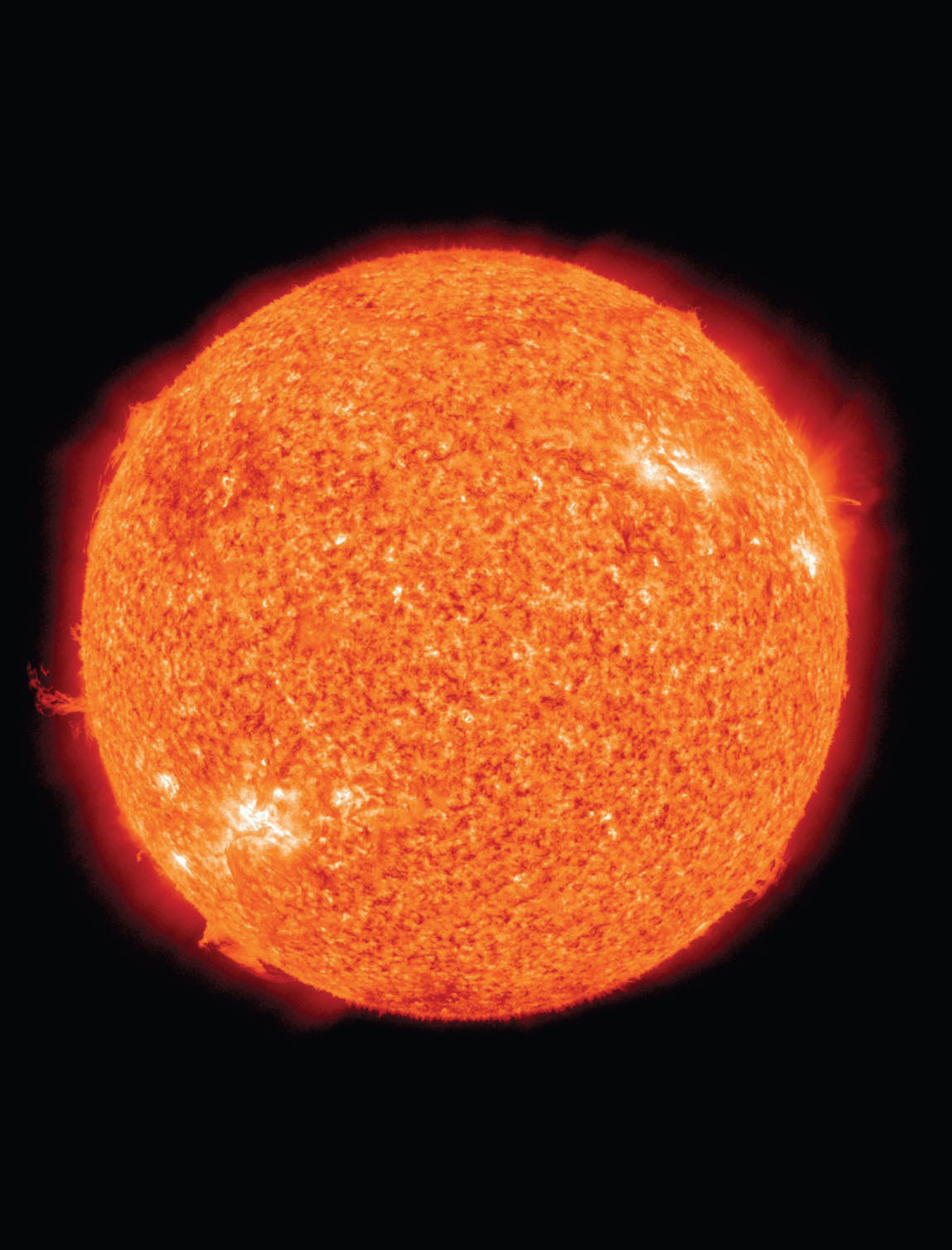
131.
The energy received from the sun every year represents approximately 10,000 times as much as our total annual energy use
Humans tend to tackle problems head-on whereas living organisms, through the process of evolution, have tended to change a problem before resolving it. Nowhere is this more apparent than in the realm of energy. We have generally tried to meet our perceived needs by just creating more and more energy rather than thinking about how we could develop solutions that, just as in nature, need far less energy in the first place.
Energy is one of our greatest challenges, partly due to the increasingly urgent realities of climate change and partly due to a failure of strategic planning. How will we decarbonise our economies over the course of the next few decades? What will this imply for designing buildings and cities?
Energy needs include and exceed the scale of buildings, so this chapter explores how architecture fits into the idea of energy planning. I argue that applying biomimetic principles to energy planning inevitably leads to the solar economy as a critical goal. This has significant implications for architects and urban designers. A ‘solar economy’ is one in which all our energy needs are met with renewable forms of generation.176 This shift is of critical importance. It is essential to focus on energy used in buildings, but ignoring where that energy comes from would neglect the benefits that biomimicry can offer. Energy, biomimicry and the built environment will be a crucial part of the bigger transformation to an ecological age.
Ideas about waste and ecosystems thinking are relevant here. The same contrast between human-made systems and biology (Chapters 2 and 3) would suggest four principles for a biomimicry solution to energy:
- demand reduction through radical increases in efficiency as the first priority
- a source of energy that will last indefinitely
- resilience through diversity and distributed networks
- resource flows that are non-toxic and compatible with a wide range of other systems.
Buildings are the front line for demand reduction: itself the first step towards a solar economy. The massive gains that can be made from all the resource-efficient innovations we have seen in previous chapters make improving buildings crucial, as they apply at such scale yet can be implemented by small groups of people. The other three principles underpin larger-scale schemes in masterplanning and urban design, informing the kinds of technologies that are suitable and how they should be integrated. Biomimicry has also been used to design better renewable energy technologies, learning from humpback whales, razor clams and palm trees.
Energy source
Turning first to the most contentious principle: where should our energy come from? If we look at the flows of energy in nature, we find that biological organisms run entirely on current solar income.177 Could we do the same and transform from a fossil-fuel global economy into a solar economy, rather than a nuclear one? Some might scoff at such an idea, but if one looks at the amount of solar energy available, the possibilities come into perspective.178 The energy received from the sun every year represents approximately 10,000 times as much as we currently use.179 This bountiful source of energy has sustained life on earth for billions of years and could supply all of our needs indefinitely. A nuclear-powered future is not our only option.180 For example, building concentrated solar power plants over roughly 5 per cent of the world’s deserts would be enough to provide all of our energy needs.181
A solar economy is one that is powered entirely by forms of renewable energy:
- direct solar energy: principally photovoltaics and concentrated solar power
- indirect solar energy: wind, wave and biomass
- related natural-source: tidal and geothermal energy.182
These are the principles advocated for here and the rest of this chapter argues the case for this approach.
Resilience
The need for resilience, which is ‘the capacity of any entity … to prepare for disruptions, to recover from shocks and stresses, and to adapt and grow from a disruptive experience’ (see Chapter 3), also applies to energy generation. In nature, systems have evolved resilience through complex interconnected networks and a high degree of diversity, such that critical ecosystem functions can be delivered by a number of organisms. For human energy needs, resilience takes two forms: first, a resilient system would provide the required quantities of energy from a diversity of interconnected generation forms; second, the system would store energy in quantities sufficient to cover any variability inherent in the energy source. Additionally, any system must address the centralisation versus local generation question.
The solar economy starts with the benefit of a constant stream of photons from the sun. The energy available takes predictable forms: between day and night, seasonal variations, the tides and wind patterns. Biological organisms have had to adapt to these same conditions, and all store energy: plants generally store it as sugar, animals as fat. In engineering, the common solutions to variability in power sources are batteries and pumped storage schemes (which pump water from a low-level lake to a high-level one so that it can be released through turbines when required183).
The other way in which nature manages fluctuations in energy supply is by simply doing more growing or metabolising when there is energy available, and less when there isn’t. We can apply the same principles by using smart controls that switch equipment off during short-term peaks or varying the cost of electricity to redistribute demand. A good example of this technology is Encycle, which was inspired by ‘swarm logic’. Swarm logic is the way that some systems achieve emergent properties, in which a relatively simple set of rules can result in complex behaviour (similar to that seen in social insects, such as bees and termites). Encycle uses inter-communicating controls on each piece of electrical equipment in a building that ‘cooperate’ to reduce peak loads and increase efficiency. The physicist David MacKay has shown that a combination of managing demand, pumped storage and batteries in stationary electric vehicles (assuming most transport is electrified) would be sufficient to deal with the fluctuations that would arise from a solar economy.
The energy sources for both nuclear (massively centralised large-output stations) and fossil-fuel generation (centralised but in smaller plants) are problematic. Fossil fuel consumption contributes to dangerous climate change and nuclear plants are heavily, although not exclusively, dependent on high-grade uranium, which is only found in a few countries. In resilience terms, a nuclear fission-only energy strategy would create significant geo-political risks: one major incident could conceivably knock out a substantial part of a country’s generating capacity. From a systems perspective, much greater resilience can be achieved by a more distributed, diverse and fully interconnected network of energy generation.
To move towards a resilient solar economy, energy transmission is essential for countries where solar potential is insufficient to meet demand. It is now theoretically possible to transmit energy as high-voltage direct current (HVDC) from solar power plants in North Africa to the UK with about the same losses as conventional AC grids. The advantage of a super-grid is that a number of countries with diverse energy sources can be interconnected, and the diversity of generation and storage forms makes it easier to balance the quantity and timing of output. Such interconnection raises the need for negotiation and fair exchange to create a solar economy: one country does not have an automatic right to energy from another. Some of the countries that have the highest levels of solar energy are less politically stable and pundits might raise related geopolitical concerns. Paradoxically, this is where something that is commonly seen as a problem – energy storage – could prove to be a big advantage. The value of the energy, and the fact that it is difficult to store for longer than a few days, means that there would be great financial incentives for countries with huge solar resources to be consistent providers of solar power and very little to be gained from doing the opposite. The solar economy could therefore contribute to long-term job creation and stability.
What is the role of local production and storage in the solar economy? Can local strategies, particularly local generation, have an impact? Consider mobile phones: trivial in number 20 years ago and more than 3 billion now in use. Mobile phones could help to deliver more localised management of renewable energy production and consumption. This technology is promising and its scale in the future may surprise us. In the same way that many developing nations leapfrogged wired landlines to take up mobile phones as the more economic and effective solution, those nations – with plentiful, renewable energy available – may succeed in the solar energy revolution without the expense of building national grids.
System compatibility
Elements of any biomimetic system should be compatible with a wide range of other systems in terms of their local interaction and resource flows. An element that produces long-term toxins would be a clear case of incompatibility.
The resource flows in most renewable energy technologies are very straightforward. In some cases, heat is captured from the sun or a geothermal source to drive a thermal engine; in other cases, kinetic energy from the wind, ocean currents or waves is used to drive a generator. While there are some toxins involved in manufacturing renewable energy technology, the energy is produced without the release of any toxins and, in many cases, renewable energy installations deliver substantial benefits.
Regarding local interaction, a recent scientific study concluded that the bases of offshore wind turbines create new habitats for crustaceans and plants, which can significantly boost numbers of fish.184 This effect was achieved without any deliberate intention, and consequently could be enhanced by designing bases to incorporate features that promote biological colonisation. The suggestion made above, when discussing Biorock, could push this restorative effect even further by growing the foundations and creating artificial reefs. Then windfarms in coastal waters could function as marine nature reserves as well as energy generators.
Photovoltaic (PV) solar farms and concentrated solar power (CSP) installations will generally be located, for obvious reasons, in regions with high levels of solar intensity, and an intriguing benefit arises. By reducing the amount of direct sunlight that falls on the ground beneath, it makes it possible to grow a range of plants that would not normally survive in the open because of thermal stress and water loss. Grazing animals also benefit from the shade as, in most cases, their natural habitats would have included partial tree cover and they, in turn, can build the fertility of the soil. Photovoltaics offer the potential for the skins of buildings to become much closer to the photosynthetic surfaces of plants – harvesting energy from the sun so that human-made structures could shift from being static consumers of energy to net producers of useful resources. At a simpler level, PVs and CSP could provide dual benefits by shading buildings as well as generating energy. Floating PV systems are now being installed on reservoirs; an approach that reduces land-take as well as reducing evaporative losses.
Cultivating algae for biofuels is still in the early stages of development and many experiments to date have proved to be uneconomic. However, the potential exists for biofuel production to offer valuable by-products. As discussed in Chapter 2 on materials, cellulose can be extracted from algae for use in rapid manufacturing of low-energy materials. Algae cultivation could well prove to be the most effective way of reversing the loss of nutrients from the world’s soils – helping to extract minerals from seawater to create micronutrients for human consumption and fertilisers for agriculture. Taking both these secondary benefits into account could make biofuel production far more economically attractive. It is possible that algae production could eventually be deployed on the facades of buildings to provide solar shading and carbon dioxide absorption, but currently the economic viability of this is a long way off.
Demand reduction
Designers can act most directly with regard to demand reduction. The international consulting firm McKinsey’s renowned and frequently updated study ‘Pathways to a Low Carbon Economy’ concludes that many of the biggest and easiest reductions in greenhouse gas emissions can be found in the built environment.185 This applies regardless of whether we pursue a nuclear future or a solar-powered future, because most energy-efficiency improvements are cheaper than adding new generating capacity. The fastest and cheapest path to cutting greenhouse gas emissions, the report states, is a step-change in the energy performance of buildings, and then to supply all remaining needs from low- or zero-carbon sources.
What levels of energy saving are realistically achievable? Using only current technologies and maintaining or improving the average European’s quality of life, David MacKay186 shows that we could reduce our energy demands from 125 kWh per day per person (kWh/d/p) down to 68. Many of these savings involve the built environment.
Demand reduction is one area where biomimicry offers huge potential to realistically reduce this number further. We have seen numerous examples of factor-10 and factor-100 savings in resource use – delivering the same function with a fraction of the resource input. Making materials with a hundredth of the embodied energy of conventional ones and then shaping these into biomimetic, highly efficient structures could deliver the levels of resource efficiency seen in spiders’ webs, bird skulls and glass sponges. Similarly, if we could steward all of our resources in closed loops, design out the whole concept of waste and create buildings that passively thermoregulate, then we could achieve really radical reductions in energy use. Every unit of energy saved will make the overall task of decarbonising our economy easier. All of this innovation is within human and architectural capabilities.
Biomimetic technologies
Biomimicry has been applied to the design of a number of renewable-energy technologies and has delivered similar improvements to those we have seen for building technologies. For instance, a new form of wind-turbine blade, developed by a marine biologist with the engaging name of Dr Frank Fish, was inspired by the tubercles on the flippers of humpback whales (fig. 132). These lumps on the front of the fins induce vortices which create more lift and allow the whale to maintain manoeuvrability at low speeds.187 Dr Fish’s new wind turbine blade incorporates the same idea to produce a wind turbine that will maintain operation at slow speeds. The reason this is of radical importance is that all wind turbines have a minimum speed of operation, below which they will stop turning and only start again once the wind speed has picked up enough to overcome inertia of the turbine. The developers, Whalepower Limited, claim that the blades can improve output by 20 per cent over a year and result in quieter operation.
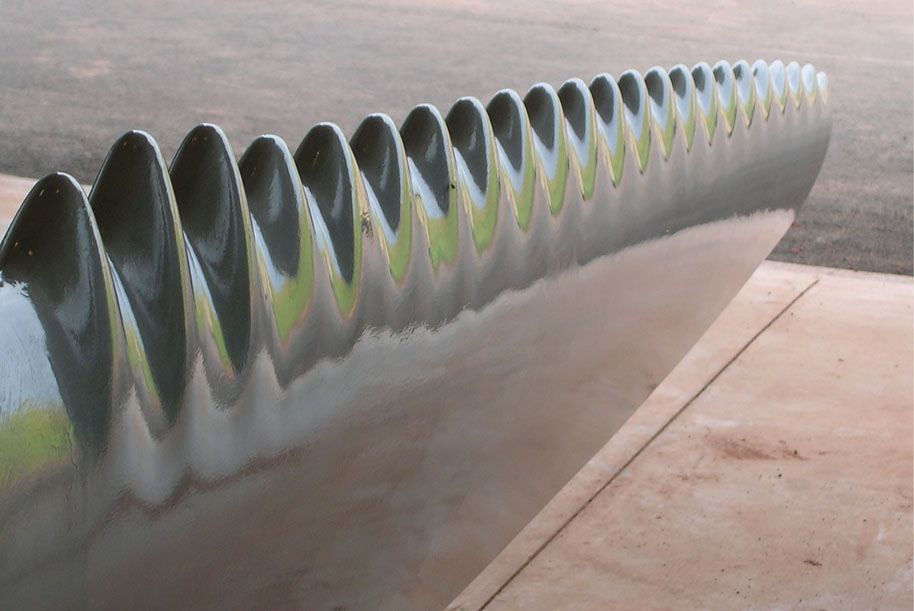
132. Wind turbine blades that mimic whale tubercles in order to maintain energy generation in lower wind speeds
Further solutions from biomimicry could help to address the opposite problem – excessive wind speed, during which less advanced wind turbines are generally taken out of operation with automatic braking systems to prevent damage. Many leaves, for instance, change orientation or roll up in high winds to minimise wind loading on the trunk of the tree.188 Most new, large-scale wind turbines now have computer-controlled systems that adjust the angle of the blades and, in time, they may be designed to flex either laterally or longitudinally under wind loading, as self-regulating structures, to present less resistance to the wind.
Clearly, this means that a smaller proportion of the available energy would be captured in very strong winds, but the big advantage is that the turbine could keep operating in these conditions. A team in the US recently announced just such a proposal: to develop a turbine, inspired by the way palm trees are swept in the direction of hurricane-force winds to reduce resistance, with blades that bend.189 The scheme is aiming for the astonishing scale of 50 MW with 200 m long blades, compared to the largest wind turbines currently on the market at an already impressive 8 MW with 80 m long blades. This exemplifies one of the key differences between living organisms and engineering (the former are environmentally responsive while the latter tends not to be) and what can be achieved by following examples from nature.
Scientists at the California Institute of Technology have researched the way that fish swimming in shoals have evolved to optimise the use of vortices created by other fish in front of them.190 They then applied the same principles to a field trial of vertical-axis wind turbines and found that far more energy per unit of land area can be extracted from the wind (figs 133 & 134).191
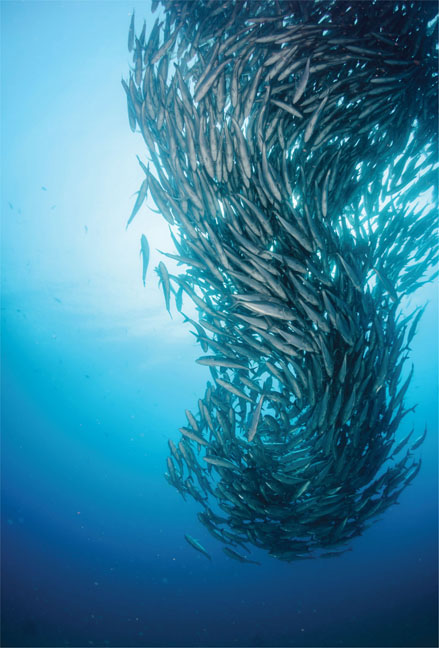
133. Shoaling fish swim in formations that optimise the use of eddy currents
Offshore locations are often favoured for large-scale wind turbines because of the favourable wind conditions, but the installation of the bases represents a major headache for the industry. Recently, a new approach has been adopted that appears to have been inspired by the elegant way that razor clams bury themselves in the sea bed. The clam sucks water into the region immediately under it, which turns the sand into a thixotropic liquid so that it sinks in rapidly, with no undignified scrabbling. The ‘suction bucket’ foundation for wind turbines works the same way – the upturned bucket-like base is lowered onto the sea bed, then water is pumped out of the top, which draws water and sand in underneath, causing the wind turbine base to steadily ‘suck’ its way into the sea bed. The technique could potentially be improved by vibrating the bucket as the razor clam does its shell to aid liquefaction of the surrounding sand.
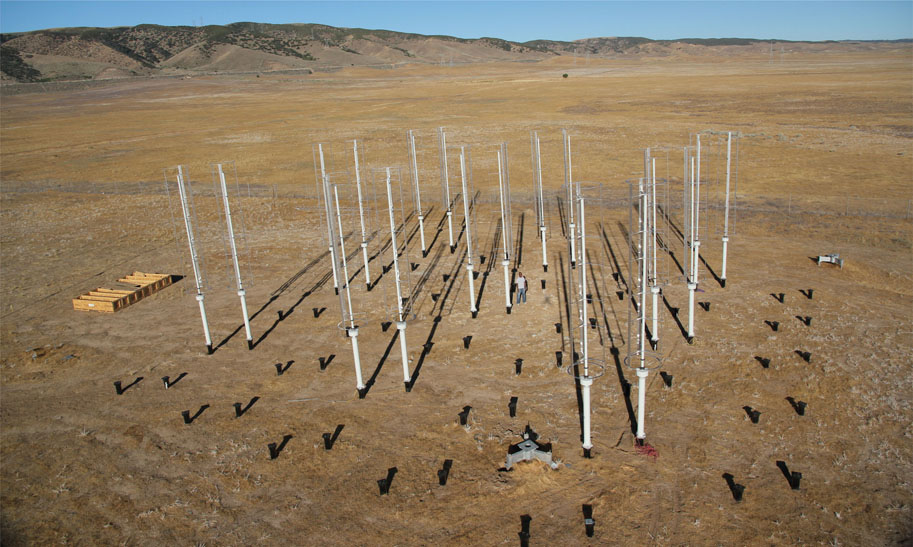
134.
Scientists at the California Institute of Technology have applied the same ‘shoaling principle’ to the spacing of vertical wind turbines and demonstrated a substantial increase in energy generation
Solar technologies have benefitted from biomimetic breakthroughs in lenses and geometrically optimised layouts for mirrors based on sunflowers that increase efficiency and reduce land area requirements (fig. 135).192 It is highly likely that biomimicry will be used in the near future to solve other challenges, such as self-cleaning surfaces and perhaps scratch-proof coatings for mirrors based on the sand skink, which can swim through sand without suffering abrasions.193 Artificial photosynthesis is another area of intensive research focus and this will almost certainly lead to further breakthroughs in solar technology.194
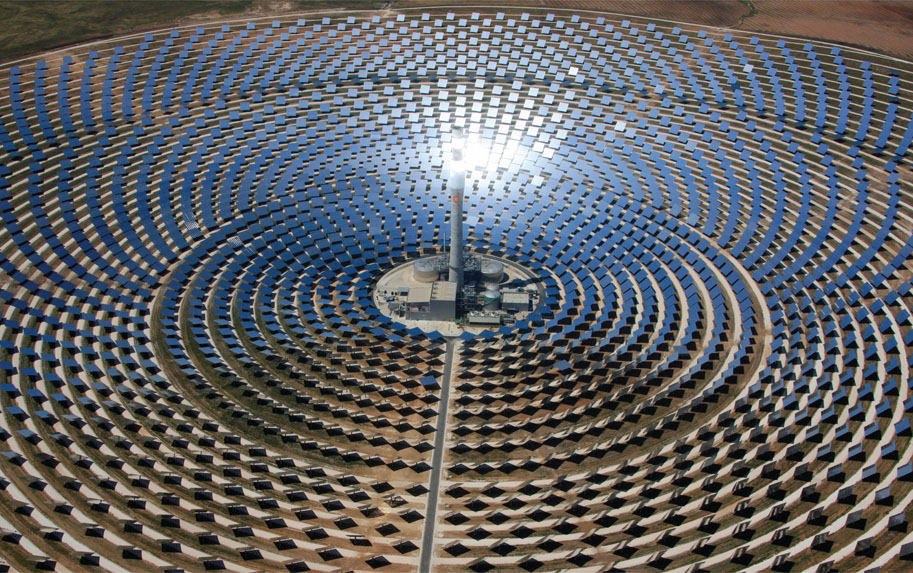
135. Concentrated solar power (CSP) mirrors laid out with phyllotactic geometry to optimise energy generation. (Gemasolar solar thermal plant, owned by Torresol Energy ©SENER)
Biomimetic windows, which make areas of a building facade into something more closely resembling a leaf or a forest, as they process sunlight from the whole surface area, are an increasingly realistic possibility.195 The potential of a truly clear solar-energy window has such a broad and large-scale application that it promises the kind of resource gain to be seen if we could widely implement biomimetic concrete.
Integrated approaches
The Green Power Island (fig. 136), designed by architects Gottlieb Paludan, is a speculative but highly realistic proposal that integrates a number of renewable energy technologies and energy storage systems in a symbiotic cluster.
The starting point for the scheme is that many forms of renewable energy are variable in terms of their output and that forms of energy storage are needed in order to create a resilient system. The Green Power Island concept overcomes this problem by creating a large reservoir that can be used in the same way: it can be emptied using excess renewable energy and then generate power when required by allowing the sea to flood back in through turbines. The reservoir has a capacity of 22,000,000 m3, which gives a generating potential of 2.3 GWh – enough to supply electricity to all the households in Copenhagen for 24 hours.
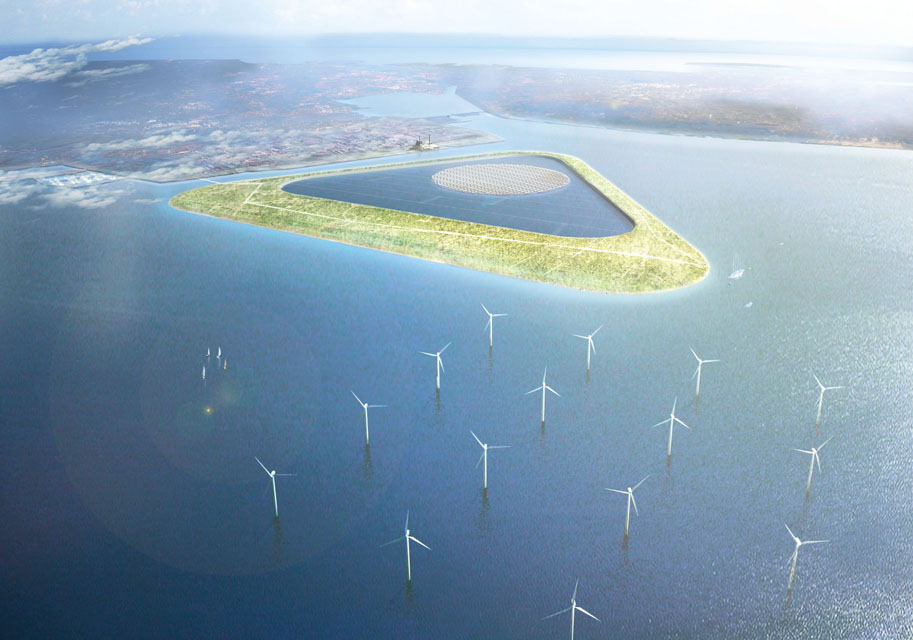
136. Green Power Island: a good example of how we will increasingly see renewable energy systems deployed in clusters to optimise synergies and deliver regenerative benefits
The project shows how effectively and compatibly a number of renewable energy technologies can be integrated. The flat areas of the island surrounding the reservoir provide ideal conditions for locating wind turbines – straightforward foundations and clear access to wind. The area below the turbines can be used for growing biomass or food crops. Within the reservoir a floating array of photovoltaics is proposed, which offers the benefit of simple solar tracking – the panels can move in one plane only so that their inclination follows the altitude angle of the sun while the floating base can rotate to follow the sun’s path from east to west. The outer edges of the island provide breeding grounds for seabirds while the sloping boulder walls below sea level effectively create new rocky shoreline. Whereas flat, rocky sea beds often have relatively low levels of biodiversity, rocky shorelines are amongst the richest habitats that can be found, so this scheme could substantially boost biodiversity and help to rebuild fish stocks.
Most of the world’s cities are in coastal locations and some have been extended by land reclamation. The Green Power Island could be built adjacent to such areas and, in the longer term, provide useful protection for low-lying urban areas against sea-level rise. In many low-lying coastal areas, the greatest risk of flooding comes from large waves breaking over the sea defences. Tidal lagoons or versions of the Green Power Island positioned offshore in such locations would prevent large waves hitting the shore and potentially obviate the need for the expensive job of raising sea walls. While the scheme illustrated opposite was designed for Denmark, the architects have proposed similar schemes for sites in the US, Bahrain, India and China, with forms of renewable energy best suited to each.
Conclusions
Handled correctly, addressing our energy challenges could drive the greatest wave of innovation that civilisation has ever seen. Any rational approach to cutting greenhouse gas emissions will require radical increases in efficiency as a first step, and innovations in the built environment offer some of the biggest opportunities.
We know from a strategic look at the numbers regarding available energy that it is physically possible to create a solar economy. We also know that there would be major benefits: cleaner air, restored ecosystems with boosted biodiversity and nations connecting to share resources, such that energy becomes an issue that promotes cooperation rather than breeding conflict. A biomimetic solution would be resilient, non-toxic, regenerative and based on an inexhaustible energy source.
Models for a solar economy suggest that we will need roughly 3.6 million wind turbines, 3 billion domestic-sized PV arrays, some large-scale tidal and hydroelectric schemes and about 600,000 km2 of CSP – all to be built and installed over the next 30 years. These may sound like daunting figures, but they should be compared with some other manufacturing achievements that we have come to accept as perfectly normal. The 3 billion PV arrays could be compared with the 3 billion mobile phones and roughly the same number of personal computers that have come into existence over the past 20 years. Likewise, the quantity of CSP, hydro-electricity and marine renewables could be compared to the 50 million cars that we make every year and the 24.5 million tonnes of new ships produced by the shipbuilding industry every year. Is creating the solar economy really beyond the realm of what modern civilisation has achieved already? The economic viability of this is complicated by a number of factors. We will need to spend large sums anyway on upgrading our creaking grids and power stations. Appropriate investment in research and development, coupled with economies from scaling up manufacturing and deployment of renewable technologies, would radically reduce costs. We also need to consider what costs are externalised from conventional sources of energy (the damage cost of carbon emissions and the cost of oil-related military operations, to name just two) and what benefits are generally overlooked in renewable energy technologies. A full economic assessment would need to take account of all these issues. The obstacles to creating the solar economy are mainly political.
Renewable energy technologies are maturing and coming down in cost at a dramatic rate. I believe we will increasingly see renewable energy in symbiotic clusters – offshore wind turbines with bases that also harvest wave energy and incorporate tidal stream turbines; tidal lagoons with wind turbines on their impoundment walls and wave-energy generation on their seaward sides; CSP installations that also cultivate algae for biofuels and produce methane from waste. If these are to be integrated sensitively into landscapes and cities, then there is a strong case for that being done by architects, engineers and ecologists in collaborative teams. The new infrastructure of the solar economy will present a whole range of design opportunities and we will increasingly see renewables deployed in order to deliver secondary benefits, such as shading buildings and reducing evaporation from reservoirs. Many renewable energy installations will also be regenerative: offshore windfarms with bases that maximise colonisation, tidal lagoons that create new stretches of rocky shoreline and solar installations that help to revegetate deserts.
Although substantial challenges remain, the solar economy is now achievable in practical terms. A vital part of the solution will be solar power installed in the world’s deserts on a massive scale. Also critical to the transformation from fossil fuels to solar energy will be individual buildings and local systems designed to deliver radical increases in resource efficiency.
